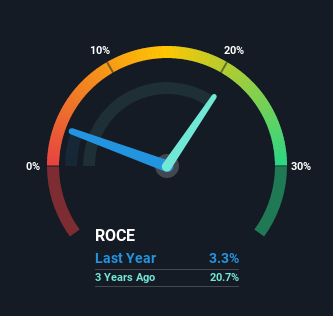Greaves Cotton's (NSE:GREAVESCOT) Returns On Capital Tell Us There Is Reason To Feel Uneasy

What financial metrics can indicate to us that a company is maturing or even in decline? A business that's potentially in decline often shows two trends, a return on capital employed (ROCE) that's declining, and a base of capital employed that's also declining. This reveals that the company isn't compounding shareholder wealth because returns are falling and its net asset base is shrinking. So after glancing at the trends within Greaves Cotton (NSE:GREAVESCOT), we weren't too hopeful.
What is Return On Capital Employed (ROCE)?
Just to clarify if you're unsure, ROCE is a metric for evaluating how much pre-tax income (in percentage terms) a company earns on the capital invested in its business. To calculate this metric for Greaves Cotton, this is the formula:
Return on Capital Employed = Earnings Before Interest and Tax (EBIT) ÷ (Total Assets - Current Liabilities)
0.033 = ₹276m ÷ (₹13b - ₹4.6b) (Based on the trailing twelve months to March 2021).
Therefore, Greaves Cotton has an ROCE of 3.3%. In absolute terms, that's a low return and it also under-performs the Machinery industry average of 12%.
Check out our latest analysis for Greaves Cotton

Historical performance is a great place to start when researching a stock so above you can see the gauge for Greaves Cotton's ROCE against it's prior returns. If you'd like to look at how Greaves Cotton has performed in the past in other metrics, you can view this free graph of past earnings, revenue and cash flow.
What Can We Tell From Greaves Cotton's ROCE Trend?
We are a bit worried about the trend of returns on capital at Greaves Cotton. Unfortunately the returns on capital have diminished from the 24% that they were earning five years ago. On top of that, it's worth noting that the amount of capital employed within the business has remained relatively steady. This combination can be indicative of a mature business that still has areas to deploy capital, but the returns received aren't as high due potentially to new competition or smaller margins. So because these trends aren't typically conducive to creating a multi-bagger, we wouldn't hold our breath on Greaves Cotton becoming one if things continue as they have.
On a side note, Greaves Cotton's current liabilities have increased over the last five years to 36% of total assets, effectively distorting the ROCE to some degree. Without this increase, it's likely that ROCE would be even lower than 3.3%. While the ratio isn't currently too high, it's worth keeping an eye on this because if it gets particularly high, the business could then face some new elements of risk.
In Conclusion...
In summary, it's unfortunate that Greaves Cotton is generating lower returns from the same amount of capital. In spite of that, the stock has delivered a 3.5% return to shareholders who held over the last five years. Either way, we aren't huge fans of the current trends and so with that we think you might find better investments elsewhere.
One more thing to note, we've identified 1 warning sign with Greaves Cotton and understanding it should be part of your investment process.
While Greaves Cotton may not currently earn the highest returns, we've compiled a list of companies that currently earn more than 25% return on equity. Check out this free list here.
When trading Greaves Cotton or any other investment, use the platform considered by many to be the Professional's Gateway to the Worlds Market, Interactive Brokers. You get the lowest-cost* trading on stocks, options, futures, forex, bonds and funds worldwide from a single integrated account. Promoted
New: Manage All Your Stock Portfolios in One Place
We've created the ultimate portfolio companion for stock investors, and it's free.
• Connect an unlimited number of Portfolios and see your total in one currency
• Be alerted to new Warning Signs or Risks via email or mobile
• Track the Fair Value of your stocks
This article by Simply Wall St is general in nature. It does not constitute a recommendation to buy or sell any stock, and does not take account of your objectives, or your financial situation. We aim to bring you long-term focused analysis driven by fundamental data. Note that our analysis may not factor in the latest price-sensitive company announcements or qualitative material. Simply Wall St has no position in any stocks mentioned.
*Interactive Brokers Rated Lowest Cost Broker by StockBrokers.com Annual Online Review 2020
Have feedback on this article? Concerned about the content? Get in touch with us directly. Alternatively, email editorial-team (at) simplywallst.com.
About NSEI:GREAVESCOT
Greaves Cotton
Operates engineering and mobility retail business in India, Middle East, Africa, Southeast Asia, and internationally.
Adequate balance sheet second-rate dividend payer.


